Peaches are refreshing and packed with antioxidants, but did you know there are numerous varieties to choose from?
The fruit originates from northwest China, growing from the Prunus persica tree.
Research shows that there are over 300 varieties of peaches in the U.S. They are categorized in terms of size, shape, and color.
Understanding the various types of peaches is essential as some are reserved for salads, others for grilling, while a few are best for baking.
Our detailed guide covers the different types of peaches, including what makes them vary and their uses.
Table of Contents
31 Different Types of Peaches
Peaches are classified into three categories: clingstone, freestone, or semi-freestone. These categories depend on how the fruit houses its pits or seeds.
Here’s a breakdown of the three categories and the various types of peaches under each category.
Freestone Peaches
Freestone peaches have flesh that easily falls away from the pit when you cut it apart.
You’re likely to come across this type in supermarkets. These peaches are bigger than other varieties but not as juicy as semi-freestones.
A freestone peach has white or yellow flesh. You can use these peaches in baked goods or consume them when fresh. It’s also easier to preserve and can them.
Some common types of freestone peaches include:
1. Nectarines

Although most people consider nectarines a separate fruit, it’s a type of peach without any fuzz.
Nectarines are juicy and very sweet with yellow or white flesh.
‘Southern Belle,’ ‘Nectar Babe,’ and ‘Harko’ are a few nectarine varieties.
2. Freestone Varietal Peaches
Freestone varietal peaches are of different types.
- The ‘O’Henry’ peach is the most common type with thin red skin. This variety matures in late summer, and most people enjoy the delicate balance of tartness and sweetness. These peaches are eaten raw, mixed in drinks, or used to make sorbets and preserves.
- The ‘Red Top’ peach is another variety that also has a tart and sweet flavor.
- ‘Elegant Lady’ peaches are another type of varietal peach, commonly used for canning, baking, and snacking.
3. ‘Madison’ Peaches
‘Madison’ peaches have tough flesh that changes from dark yellow to red.
They have a very delicate yet sweet taste and make excellent snacks or can be used for desserts. You can also preserve them.
These Virginia-grown peaches are harvested in fall and hold up well when you need to freeze and can them.
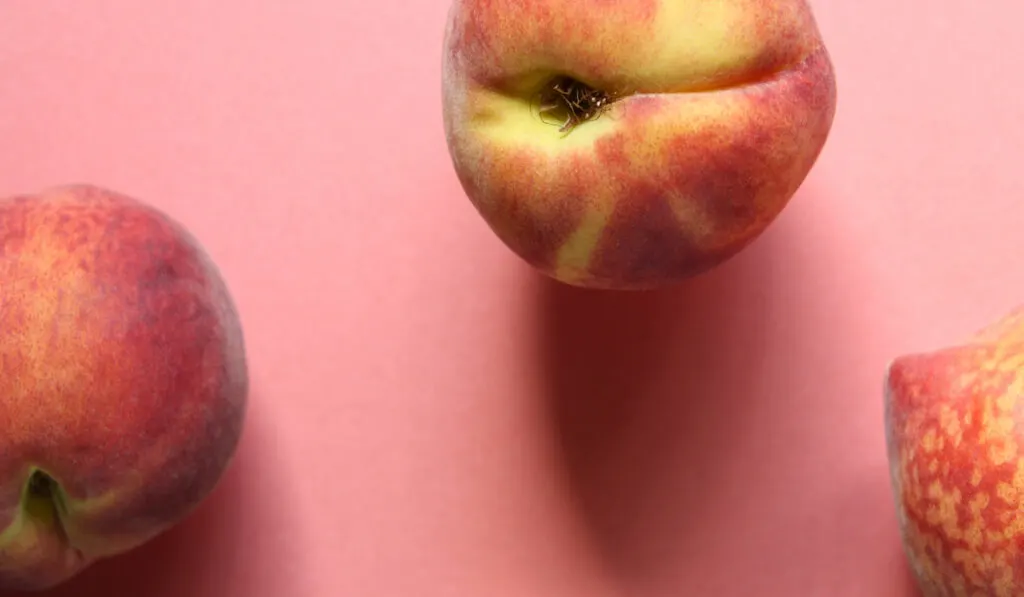
4. ‘Honey Babe’ Peaches
‘Honey Babe’ peaches are soft and tiny.
While they are not as sweet as nectarines, they lack acidity in their flavor. Their yellow flesh is also a distinctive characteristic.
5. ‘El Dorado’ Peaches
‘El Dorado’ peaches grow on short trees, but they are medium-sized. These peaches are best for salads and desserts.
6. ‘August Pride’ Peaches
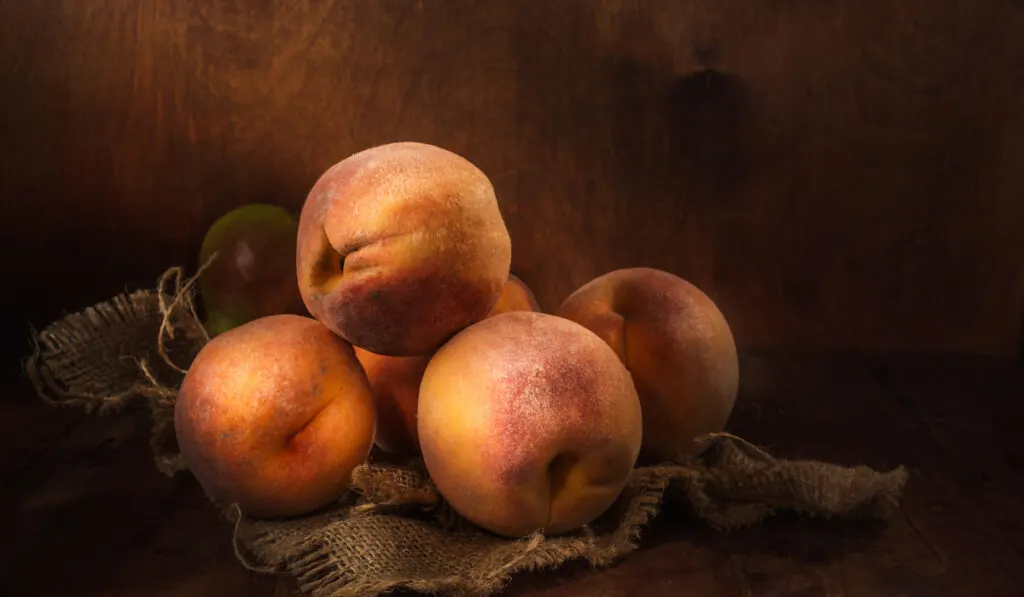
‘August Pride’ peaches mostly grow in California. They are big and have soft, red skin.
Unlike ‘Honey Babe’ peaches with bright yellow flesh, these have light yellow flesh.
7. ‘Forty-Niner’ Peaches
‘Forty-Niner’ peaches are enormous and have yellow skin. While they may not be extra sweet, these peaches are still great to snack on.
However, ‘Forty-Niner’ peaches are delicate and require special care when handling.
8. ‘Tropic Snow’ Peaches
‘Tropic Snow’ peaches get their name from the time they are harvested. They are ready in June.
‘Tropic Snow’ peaches have sweet, white flesh, and bold red skin.
9. ‘Ventura’ Peaches
‘Ventura’ peaches are another variety grown in California. They are popular for their small shape and deep red skin that turns yellow when faded.
Although they have a slightly acidic flavor, ‘Ventura’ peaches are sweet.
10. ‘Early Amber’ Peaches
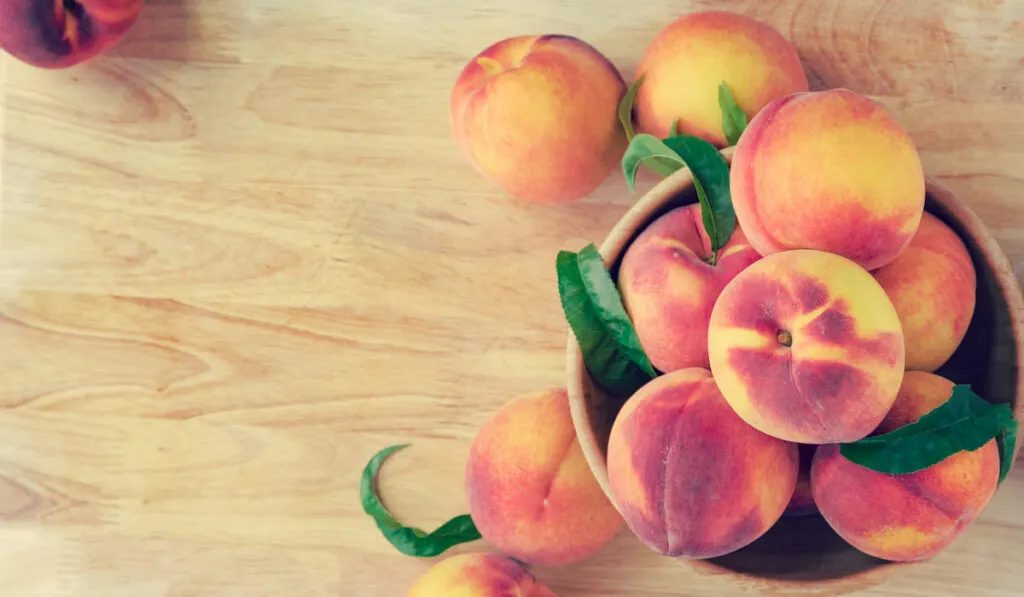
‘Early Amber’ peaches have yellow and dark red skin. These peaches are originally from Florida.
One characteristic that differentiates them from the rest is their firm texture, but they are sweet.
11. ‘Reliance’ Peaches
‘Reliance’ peaches have red and yellow skin and are prevalent in New England, where they are grown. Their yellow flesh is sweet and juicy.
Semi-Freestone Peaches
Semi-freestone peaches have easy-to-remove flesh and are juicy and sweet like clingstone peaches.
You can use them for baking and cooking, apart from eating them fresh. Additionally, you can preserve them.
Some of the peaches under this variety include:
12. ‘Coronet’ Peaches
‘Coronet’ peaches have a tangy, slightly acidic taste and soft yellow flesh. They are mainly used in desserts and peach dishes.
13. ‘Red Haven’ Peaches
‘Red Haven’ peaches are simple to grow and are an excellent choice for preservation. A ‘Red Haven’ peach has yellow flesh that’s sweet and creamy.
14. ‘Donut’ Peaches
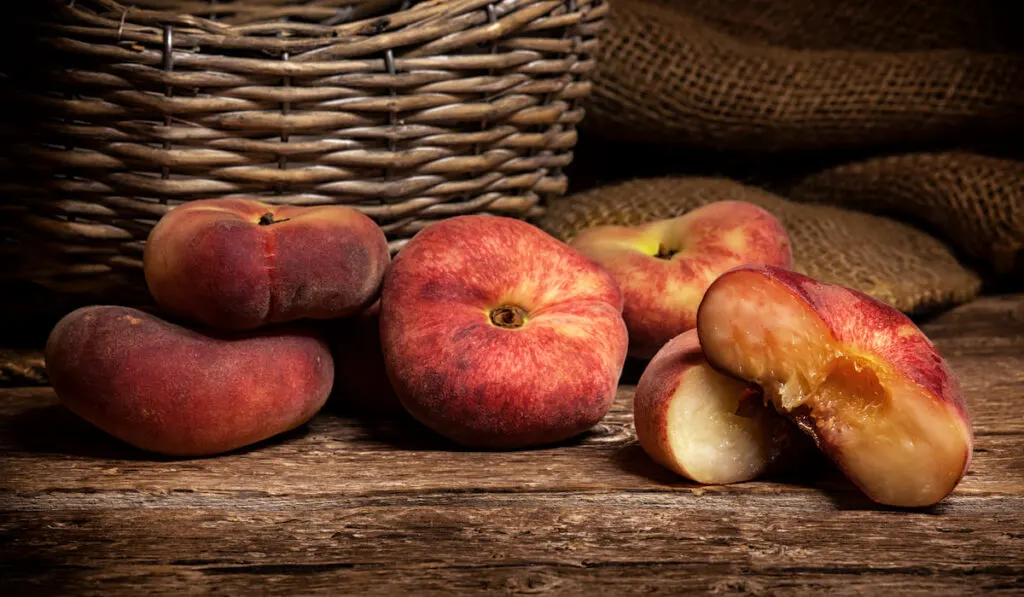
Donut peaches have a flat, saucer-like shape. This peach variety is hard to come across, and some stores may sell them at a higher cost, especially during summer.
While they are primarily a clingstone peach variety, they also fall under the semi-freestone variety.
15. ‘Babcock’ Peaches
‘Babcock’ peaches have smooth, fuzz-free skin, which is an excellent alternative for people who don’t like the fuzzy skin of peaches.
These peaches are tiny but have a delicate flavor that’s both sweet and tangy.
Clingstone Peaches
Clingstone peaches have a flesh that’s hard to separate from the seed, unlike the flesh of freestone peaches, which is soft.
However, clingstone varieties have unmatched sweetness and juiciness that you won’t find in other peach varieties.
Peaches under this variety have a crisp texture, and their flesh can be a bright yellow or red.
It’s not easy to find clingstone peaches in stores, but you might be lucky to find them in farmer’s markets.
You can eat these peaches when fresh, use them in juicing or make jams.
Some of the popular types of clingstone peach varieties include:
16. ‘Cardinal’ Peaches
‘Cardinal’ peaches are bright red and have a sweet taste that’s not overwhelming. Similar to ‘Cresthaven’ peaches, the ‘Cardinal’ peaches also have firm skin, and you can preserve them for later use.
17. ‘Peento’ Peaches
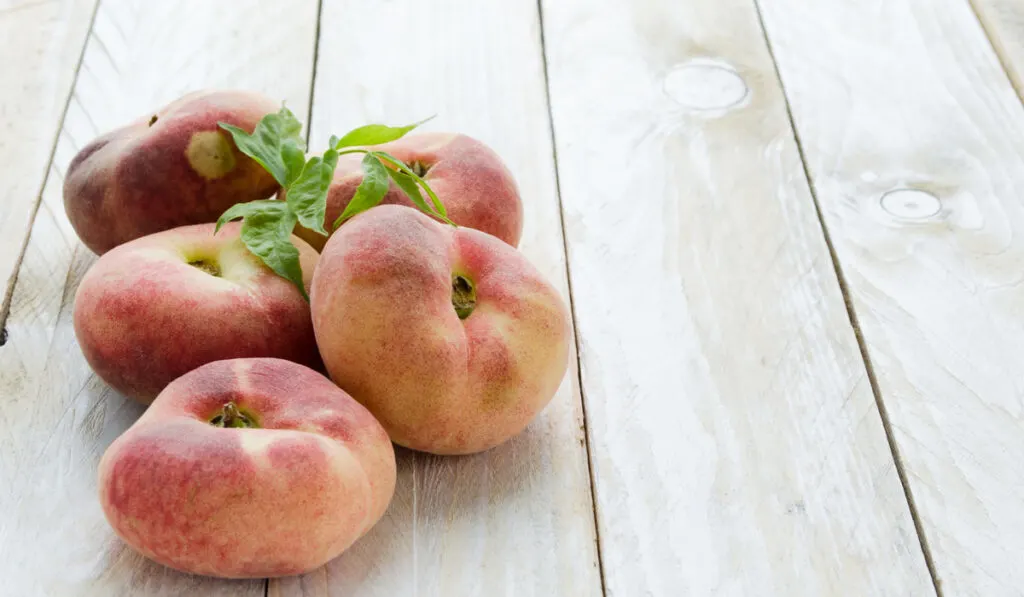
‘Peento’ peaches have a flat shape and are prevalent in California and Washington. They have yellow, red, or orange outer skin.
18. ‘Arctic Supreme’ Peaches
‘Arctic Supreme’ peaches have cream and red skin, while their flesh is white and flavorful. They also have a similar texture to cantaloupes.
19. ‘Melba’ Peaches
‘Melba’ peaches are popularly used in peach melba and make a delicious dessert.
These peaches are cut in the middle and poached for pies, ice creams, or purees. ‘Melba’ peaches have sweet, white flesh and yellow skin and are large.
20. ‘Cresthaven’ Peaches
‘Cresthaven’ peaches are bigger than regular peach varieties. They are sweet and very juicy.
You’ll love the long shelf life of these peaches, thanks to their firm flesh. You can preserve them and make fruit jam with this peach variety.
21. ‘White Health’ Cling Peaches
‘White Health’ cling peaches have a white and red color. Although their flesh is soft and juicy, they have firm skin.
‘White Health’ cling peaches are juicy and large. They are grown in Maryland.
22. ‘Snow Beauty’ Peach
‘Snow Beauty’ peaches are a large variety with stunning red skin contrasting nicely with the white flesh. They are best consumed fresh as a snack.
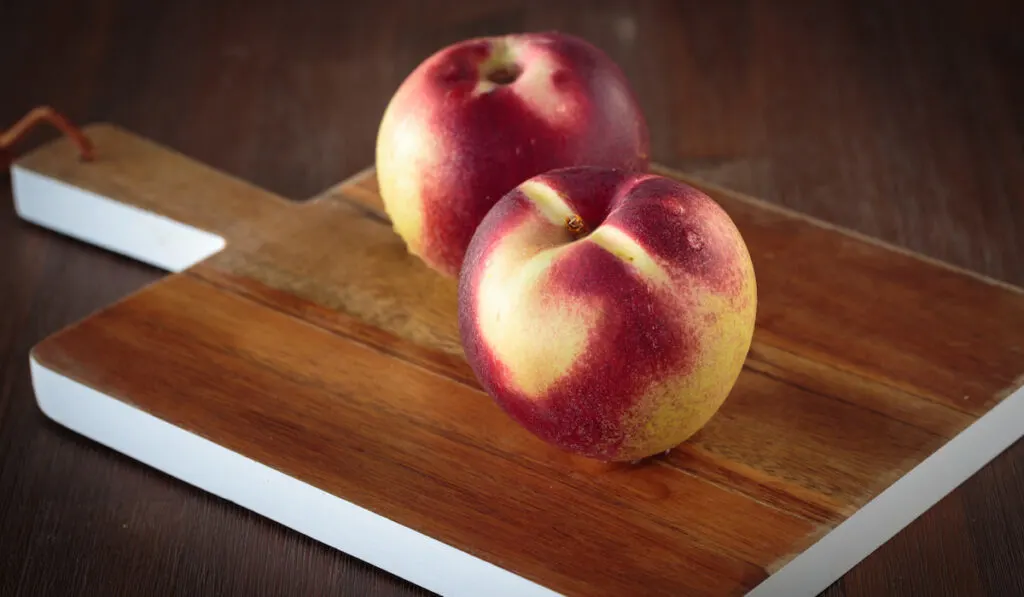
Other Types of Peaches
Apart from the categories listed above, there are peaches that don’t fall under any of the three categories. These include:
23. ‘Halloween’ Peaches
Halloween peaches are harvested when it’s close to Halloween time.
They are big and have yellow skin with some hints of red. Their yellow flesh is flavorful and sweet.
24. ‘Polly’ Peaches
‘Polly’ peaches have white and red outer skin. They are medium-sized with white, juicy flesh. These peaches are grown in Iowa and are harvested mid-season.
25. ‘Rio Grande’ Peaches
‘Rio Grande’ peaches are originally from Florida. They have yellow flesh with a fine texture.
‘Rio Grande’ peaches are perfect when eaten fresh.
26. ‘Frost’ Peaches
‘Frost’ peaches are medium-sized and have yellow flesh. They are harvested in mid-season and have a distinct tangy flavor.
27. ‘Melting Flesh’ Peaches
‘Melting Flesh’ peaches tear easily when you cut them with a knife.
These peaches have both freestone and clingstone varieties. Apart from being eaten raw, ‘Melting Flesh’ peaches make great desserts and pies.
28. ‘Fairhaven’ Peaches

‘Fairhaven’ peaches have red-blushed sides and some yellow streaks. Although this peach variety has yellow flesh, it quickly turns red as you move to the pit.
You can freeze this variety as it has a firm texture and doesn’t brown quickly.
29. ‘Indian Blood’ Peaches
The Spanish introduced ‘Indian Blood’ peaches to Mexico in the 1500s.
The variety gets its name from the red skin that hides yellow flesh that also features red marks.
The medium-sized peach has tough skin and meaty flesh with a unique flavor.
30. ‘Harken’ Peaches
‘Harken’ peaches have red skin and are medium-sized. Unlike other peach varieties that quickly brown when cut, ‘Harken’ peaches don’t brown quickly.
31. ‘Glohaven’ Peaches
‘Glohaven’ peaches have yellow skin and are large. Their bright yellow flesh is the reason behind the glow in their name. Additionally, they have no hair or fuzz.
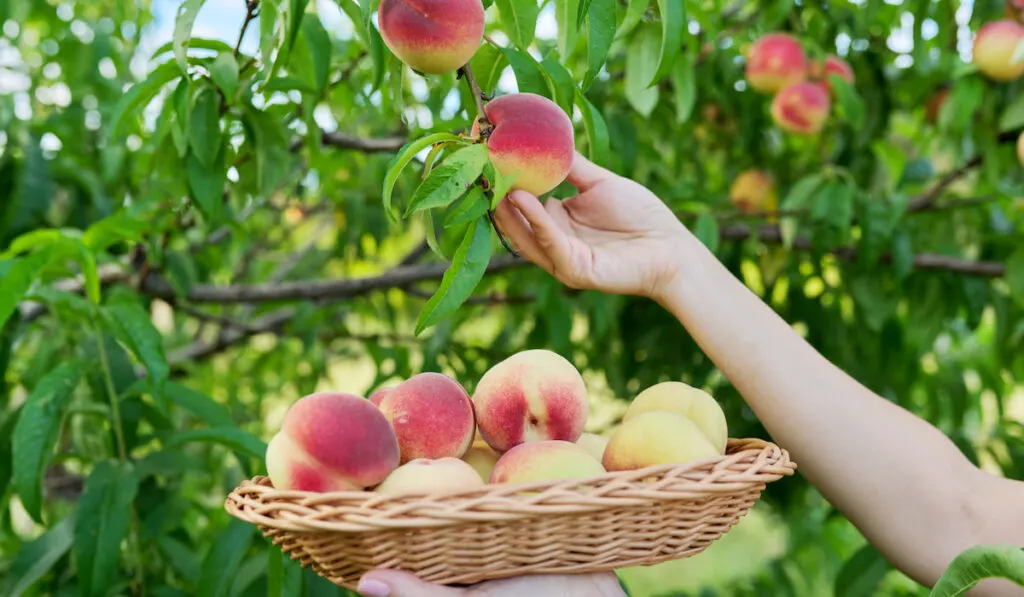
Final Thoughts
There are different peach varieties to suit your taste preferences and location. You can get extra sweet peaches and some that are both tangy and sweet.
We hope with our guide above, you now know what type best works for you, whether you’re looking for a quick snack or a peach for cooking and baking.
Resources
- https://www.appleholler.com/apple-hollers-guide-for-peaches/
- http://titanfarms.com/passion-for-peaches/all-about-peaches.aspx
- https://hgic.clemson.edu/different-kinds-of-peaches/
- https://www.gardeningknowhow.com/edible/fruits/peach/peach-stone-types.htm
- https://www.thespruceeats.com/varieties-of-peaches-4057064
- https://fruitstand.com/blogs/stories/different-types-of-peaches
- https://aic.ucdavis.edu/profiles/Peach-2006B.pdf
